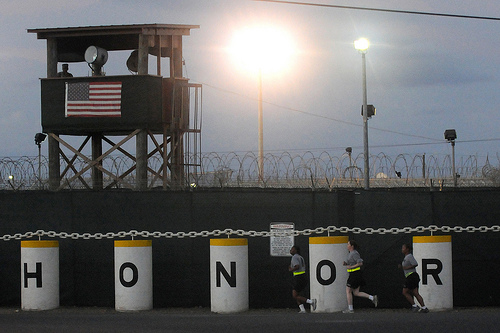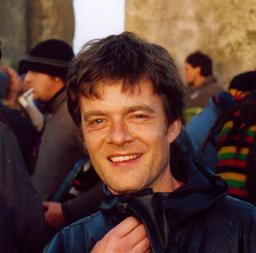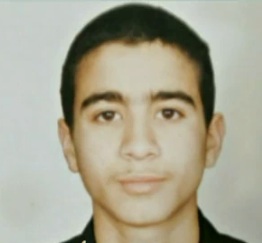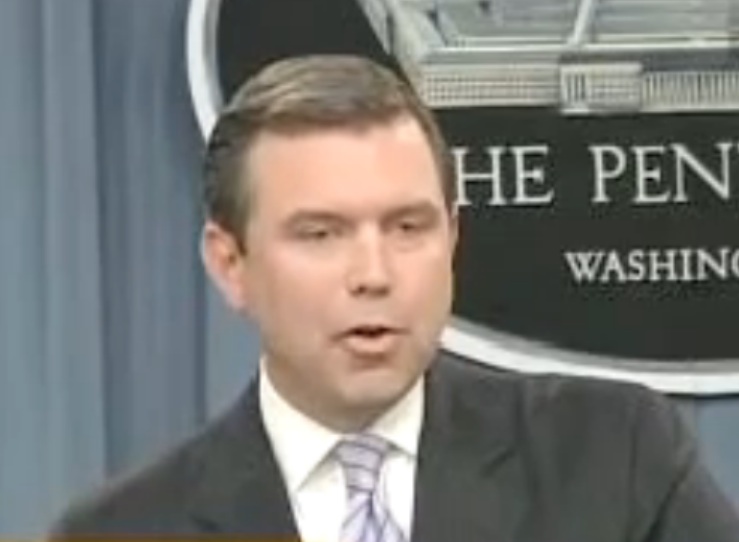 “We are getting into classified and unclassified. All this is just about me proving what I did. If I did the things I did, I would admit that I did. Things I didn’t do, I will say clearly I didn’t do them. But if the Tribunal is saying there are more classified things, classified information – they have to prove that – I am not asking to see the witnesses, if you have any. I need just their names to prove that your documents are true. I think this is not justice; it is not right. It hasn’t been witnessed in the whole human history. If you base your judgments or the accusations against me on classified information, then there is no need to continue. Let’s just stop it right here.” – Faris Muslim al-Ansari, Guantanamo Detainee (ISN #253) at his Combatant Status Review Tribunal in September 2004
“We are getting into classified and unclassified. All this is just about me proving what I did. If I did the things I did, I would admit that I did. Things I didn’t do, I will say clearly I didn’t do them. But if the Tribunal is saying there are more classified things, classified information – they have to prove that – I am not asking to see the witnesses, if you have any. I need just their names to prove that your documents are true. I think this is not justice; it is not right. It hasn’t been witnessed in the whole human history. If you base your judgments or the accusations against me on classified information, then there is no need to continue. Let’s just stop it right here.” – Faris Muslim al-Ansari, Guantanamo Detainee (ISN #253) at his Combatant Status Review Tribunal in September 2004
Seventeen years old when captured in December 2001, Fais Muslim Al Ansari (ISN:253) went before a tribunal and had his status as an enemy combatant reviewed. In his testimony, it is apparent al-Ansari, who at the time was twenty years old, understood the injustice of the system he was being subjected to at Guantanamo Bay in Cuba. This understanding likely led him to participate in a hunger strike with over one hundred other detainees, many of which would be force fed as they attempted to protest detention conditions and their inability to adequately dispute their continued detention.
The first Canadian Guantanamo file released was Omar Khadr, a much anticipated and very thin file that discussed the captured child's intelligence value as a son of a suspected Al Qaeda member and contributed nothing else of value or accuracy. (Except in this file, the 'medic' he was accused of killing in his trial is accurately described as a Special Forces soldier.)
The second widely anticipated Canadian file is that of 'Abdul Khadr', assumed to refer to Abdurahman Khadr, Omar's brother who has claimed he was in Guantanamo as a CIA plant. He was one of the ten detainees whose information was not included in the 2007 files published by the US Department of Defense under the Freedom of Information Act. Unfortunately the file does not match biographical details of any of the Khadr family (there are brothers Abdulkareem and Abdullah as well, but neither was ever in Guantanamo).
Jason Leopold, deputy managing editor of Truthout.org, tweeted "ive discovered that at least 1 of the photos in #Guantanamo files is not the detainee identified by military/govt. No idea who the person is"
So not only is all of the information about the suspects highly suspect, obtained from unreliable and tortured testimony and mistaken identities, some of the files are not even who they are labeled as.
 Andy Worthington is a journalist, blogger, and author of The Guantánamo Files: The Stories of the 774 Detainees in America’s Illegal Prison. He is also co-director of a new documentary film, “Outside the Law: Stories from Guantánamo”.
Andy Worthington is a journalist, blogger, and author of The Guantánamo Files: The Stories of the 774 Detainees in America’s Illegal Prison. He is also co-director of a new documentary film, “Outside the Law: Stories from Guantánamo”.
In 2009, Worthington revealed information about the demise of Ibn al-Shaykh al-Libi the former US 'ghost prisoner' whose alleged suicide death in a Libyan jail is still under suspicion.
Ibn al-Shaykh al-Libi's testimony, which was obtained under torture and coercion, and later recanted, was cited by the George W. Bush Administration in the months preceding the 2003 invasion of Iraq as evidence of a connection between Saddam Hussein and al-Qaeda.
The head of the Washington office of Human Rights Watch stated al-Libi was "Exhibit A" in hearings on the relationship between pre-Iraq War false intelligence and torture. Confirmation of al-Libi's location came two weeks prior to his death.
Most recently, Worthington partnered with WikiLeaks on its latest release of thousands of pages of documents regarding the cases of 758 out of 779 Guantanamo detainees dating between 2002 and 2008. The documents consist of memoranda from JTF-GTMO, the Joint Task Force at Guantánamo Bay, to US Southern Command in Miami, Florida.
You can find Mr. Worthington on his Web site or on twitter @GuantanamoAndy.
Transcript
I wanted to talk to you a little bit about a couple things that you had mentioned when you were talking with Amy Goodwin on Democracy Now. One of the things you talked about was that ‘guidelines’ needed to be set up for filtering or discriminating the content that was found in the documents. Could you tell me a little bit about what that would be like in terms of application?
Well, you know, to be honest...a certain amount of hard work is required and some of that has already been done… I am glad to know…by some of the journalists who’ve been writing about it already...who have worked out that a lot of this supposed ‘body of evidence’ consists of allegations that have been made by a small number of prisoners… who have made repeated allegations against large numbers of their fellow prisoners, which have been called into doubt.
Now, you know, the doubts about this information are not necessarily mentioned, in fact, they are rarely mentioned in these military documents.
 *With research assistance from Heather Marsh
*With research assistance from Heather Marsh
Pakistani national Naqib Ullah (also Naqibullah) was 14 years old and out doing an errand for his father when he was kidnapped from his village in Khan, Afghanistan by 11 men that called themselves, “Samoud’s people.” The men, according to Ullah, “forcibly raped him at gunpoint”. He was taken back to the men’s village encampment and “forced to do manual work.”
Ullah was in the camp for three days when, in December 2002, US forces raided the camp. The group had been forewarned. They ordered Ullah and others to stay behind and fight US forces. He was captured and had a weapon but it had not been fired. He was transported to Guantanamo Bay, Cuba in January 2003 because the military believed he might have knowledge of “Taliban resistance efforts and local leaders.”
This teenager is just one of twenty-two juveniles who wound up in Guantanamo. And, with the release of the Gitmo Files by WikiLeaks, more details on the capture, transfer, detention and release of juvenile detainees are becoming known.
Article 1 of the UN Convention on the Rights of the Child defines a child as “every human being below the age of eighteen years unless under the law applicable to the child, majority is attained earlier.”
Kevin Rudd
Minister Foreign Affairs
PO Box 6022
House of Representatives
Parliament House
Canberra ACT 2600
AUSTRALIA
Dear Minister
1) Julian Assange and Wikileaks.
Firstly I would like to say that the international community who support Julian Assange would undoubtedly thank you for your support of him on the issue of his legal rights in the UK and scotching the threats made by your colleagues the prime minister Ms Gillard and attorney general Mr McClelland to cancel his passport late last year. Your support of human rights in relation to Julian Assange is to be commended, including the intercession of our diplomats on his behalf asking certain questions of Swedish authorities (1) which it is assumed emanated from your good offices.
More could be done for example to point out to the European Union that their European Arrest Warrant System is disgracefully flawed and subject to serial abuses by member states (especially Poland) now that showing a prima facie case has been removed entirely from extradition procedures in the European Union’s EAW system. Australia as you would likely be aware, did not extradite without the applicant nation showing a prima facie case up until 1985 when the “no evidence” and “dual criminality” provisions became available to applicant nations under amended legislation.(2) Where subjected to abuse, prima facie requirements should be reinstated.
As you are also no doubt aware the US Department of Justice is leaving no pebble unturned in their vengeful attempts to find - or more likely - manufacture some evidence against Julian Assange for a charge of conspiracy to commit espionage.
This is happening despite First Amendment protections which the DOJ’s epigones are attempting to undermine as they engage in polemical arguments using gymnastic semantics in the US media, in an exercise to assert he is not a journalist as a means to preclude those rights, contrary to the US constitution.
 A statement from the Pentagon was published just after 9 pm ET on April 24th, no more than an hour or two after the New York Times had posted their package covering the Gitmo Files they had not obtained from WikiLeaks. The statement was posted on NPR and the Times website. Yet, again, it seems this is an instance of complete collusion between the press and government.
A statement from the Pentagon was published just after 9 pm ET on April 24th, no more than an hour or two after the New York Times had posted their package covering the Gitmo Files they had not obtained from WikiLeaks. The statement was posted on NPR and the Times website. Yet, again, it seems this is an instance of complete collusion between the press and government.
Michael Calderone reports "representatives from NPR and the Times visited the White House and spoke with Pentagon spokesman Geoff Morrell and members of Joint Task Force Guantanamo." And, "The news organizations agreed to some redactions requested by government officials but not all of them."
Recall, in February, it was found out that the Times had met with the State Department prior to their release of the US State Embassy Cables. Marcy Wheeler over at Firedoglake highlighted NYT’s close cooperation with the State Department:
Because of the range of the material and the very nature of diplomacy, the embassy cables were bound to be more explosive than the War Logs. Dean Baquet, our Washington bureau chief, gave the White House an early warning on Nov. 19. The following Tuesday, two days before Thanksgiving, Baquet and two colleagues were invited to a windowless room at the State Department, where they encountered an unsmiling crowd. Representatives from the White House, the State Department, the Office of the Director of National Intelligence, the C.I.A., the Defense Intelligence Agency, the F.B.I. and the Pentagon gathered around a conference table. Others, who never identified themselves, lined the walls. A solitary note-taker tapped away on a computer.
Theme by Danetsoft and Danang Probo Sayekti inspired by Maksimer